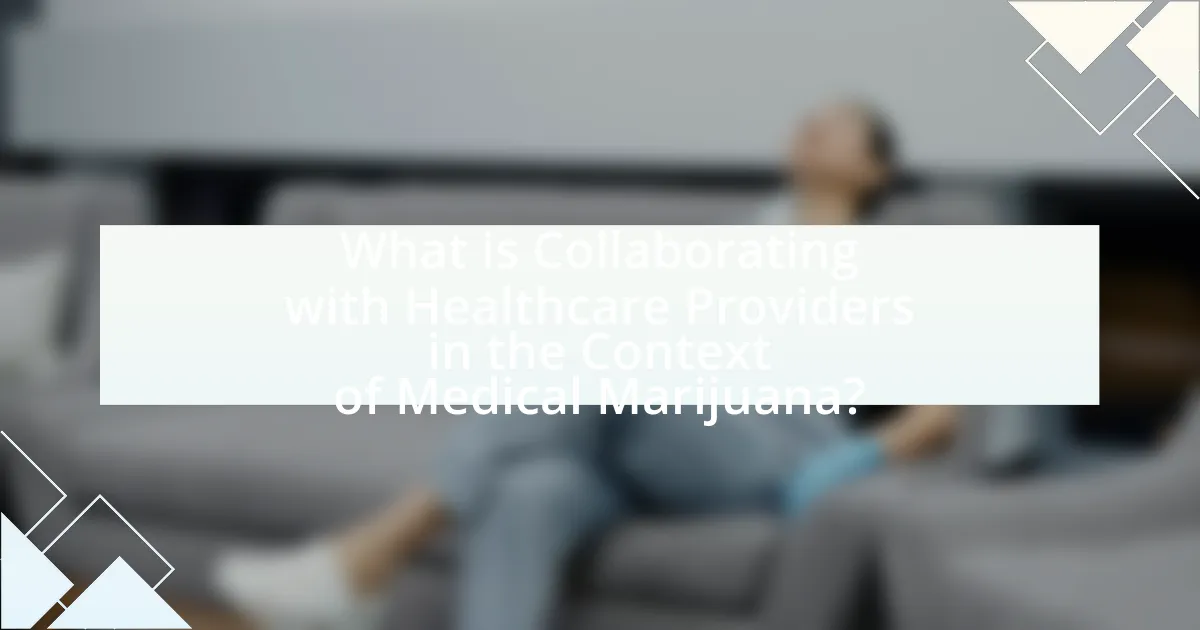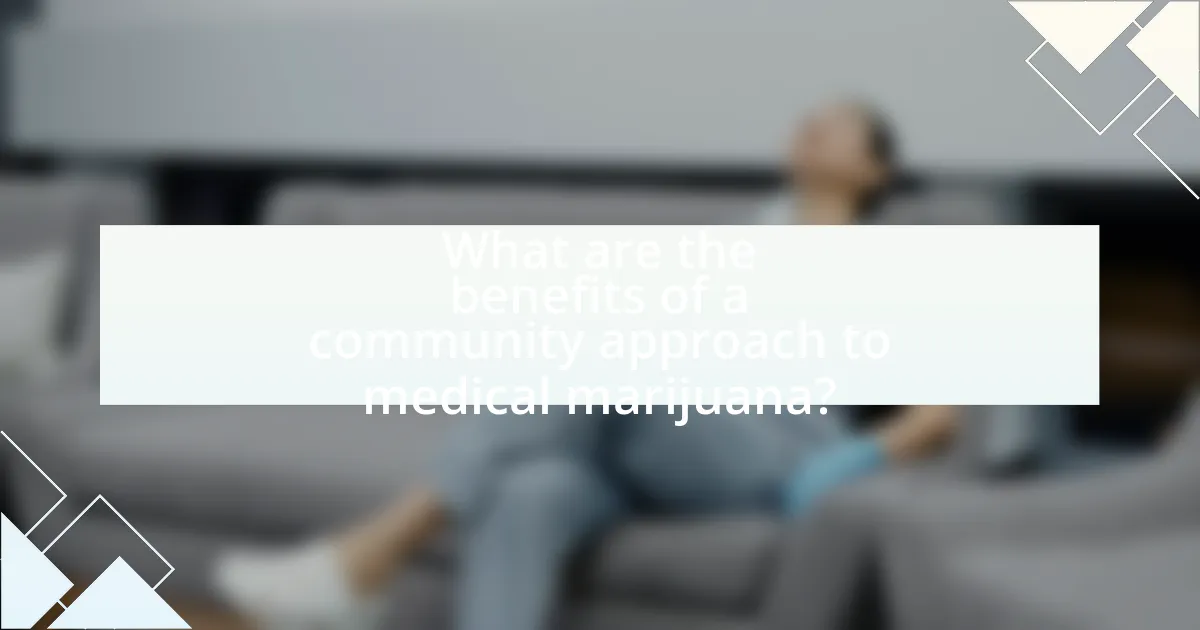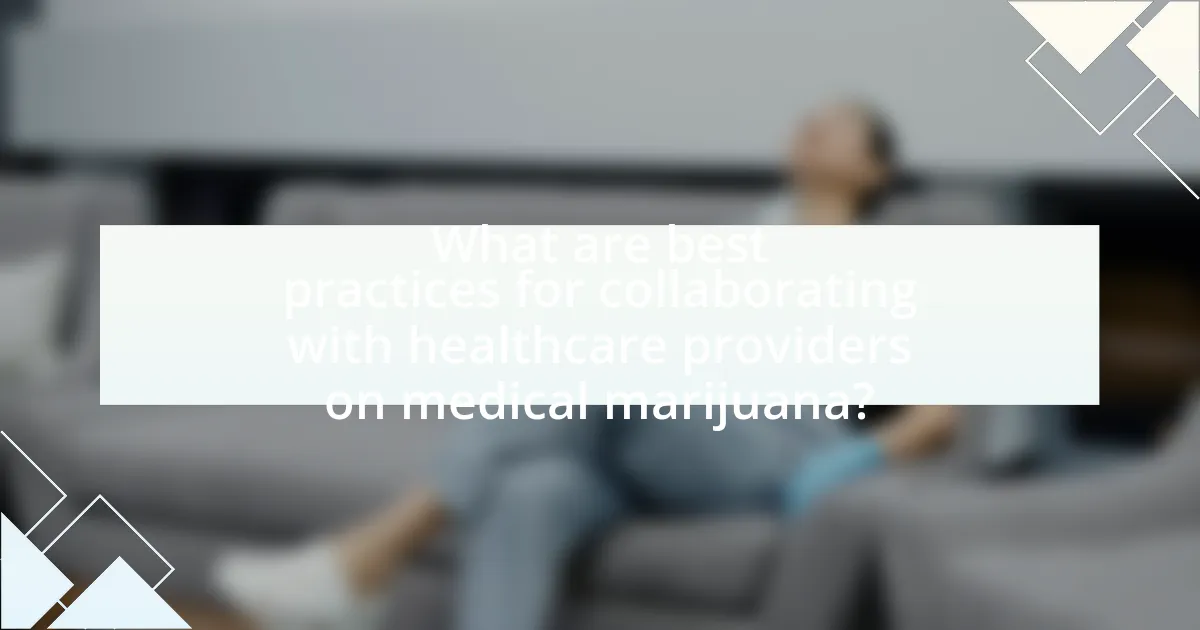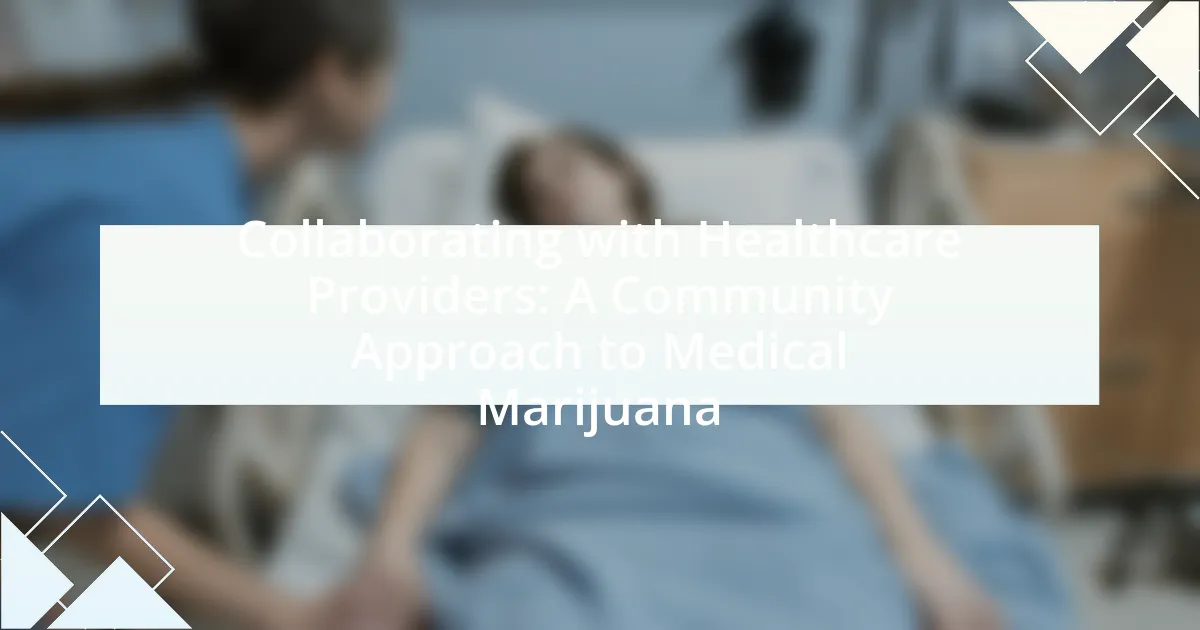Collaborating with healthcare providers in the context of medical marijuana involves a partnership among patients, physicians, and other healthcare professionals to ensure the safe and effective use of cannabis for medical purposes. This article explores how collaboration enhances treatment outcomes through comprehensive patient care, the roles of healthcare providers, and the benefits of a community approach. It also addresses challenges such as regulatory barriers and misconceptions that hinder effective collaboration. Key components of successful collaboration include clear communication, ongoing education, and community engagement, which collectively improve patient access, education, and overall health outcomes related to medical marijuana use.

What is Collaborating with Healthcare Providers in the Context of Medical Marijuana?
Collaborating with healthcare providers in the context of medical marijuana involves a partnership between patients, physicians, and other healthcare professionals to ensure safe and effective use of cannabis for medical purposes. This collaboration is essential for developing treatment plans that consider individual patient needs, medical histories, and potential interactions with other medications. Research indicates that effective communication and shared decision-making between patients and healthcare providers can enhance treatment outcomes and patient satisfaction, as evidenced by studies showing improved management of chronic pain and other conditions when medical marijuana is integrated into patient care plans.
How does collaboration enhance the use of medical marijuana?
Collaboration enhances the use of medical marijuana by facilitating comprehensive patient care through shared knowledge and resources among healthcare providers. When physicians, pharmacists, and specialists work together, they can develop tailored treatment plans that consider the unique needs of each patient, leading to improved therapeutic outcomes. For instance, a study published in the Journal of Pain Research found that interdisciplinary approaches in managing chronic pain, including the use of medical marijuana, resulted in higher patient satisfaction and better pain management. This collaborative model ensures that patients receive accurate information about dosages, potential interactions with other medications, and the overall benefits and risks associated with medical marijuana, ultimately promoting safer and more effective use.
What roles do healthcare providers play in this collaboration?
Healthcare providers play a crucial role in the collaboration surrounding medical marijuana by offering expertise in patient care, education, and regulatory compliance. They assess patients’ medical conditions to determine eligibility for medical marijuana use, ensuring that it aligns with evidence-based practices. Additionally, healthcare providers educate patients about the potential benefits and risks associated with medical marijuana, guiding them in making informed decisions. They also collaborate with other stakeholders, such as pharmacists and community organizations, to create a comprehensive care plan that addresses the holistic needs of patients. This multifaceted involvement is essential for ensuring safe and effective use of medical marijuana within the community.
How can patients benefit from healthcare provider collaboration?
Patients benefit from healthcare provider collaboration through improved care coordination, leading to better health outcomes. When healthcare providers work together, they can share critical patient information, ensuring that all aspects of a patient’s care are aligned and comprehensive. This collaboration reduces the risk of medical errors, enhances treatment efficacy, and allows for more personalized care plans. For instance, a study published in the Journal of the American Medical Association found that coordinated care models can lead to a 20% reduction in hospital readmissions, demonstrating the tangible benefits of provider collaboration for patient health.
Why is a community approach important for medical marijuana?
A community approach is important for medical marijuana because it fosters collaboration among healthcare providers, patients, and local organizations, enhancing access to care and education. This collaborative environment allows for the sharing of knowledge and resources, which can lead to better patient outcomes and informed decision-making regarding medical marijuana use. Research indicates that community-based initiatives can improve patient adherence to treatment plans and increase overall satisfaction with care, as seen in studies highlighting the effectiveness of integrated healthcare models that include community support systems.
What are the key components of a community approach?
The key components of a community approach include collaboration, engagement, and empowerment. Collaboration involves healthcare providers, community organizations, and patients working together to address health needs effectively. Engagement refers to actively involving community members in decision-making processes, ensuring their voices are heard and considered. Empowerment focuses on equipping individuals with the knowledge and resources necessary to make informed health choices. These components are essential for fostering a supportive environment that enhances the effectiveness of medical marijuana initiatives within the community.
How does community involvement influence patient outcomes?
Community involvement significantly enhances patient outcomes by fostering support networks and improving access to healthcare resources. Engaging community members in health initiatives leads to increased awareness and education about medical conditions and treatments, including medical marijuana. Research indicates that communities with active participation in health programs report better adherence to treatment plans and improved health literacy, which directly correlates with positive patient outcomes. For instance, a study published in the Journal of Community Health found that community-based interventions resulted in a 30% increase in patient engagement and a 25% improvement in health outcomes among participants. This evidence underscores the critical role of community involvement in shaping effective healthcare delivery and patient success.
What challenges exist in collaborating with healthcare providers on medical marijuana?
Collaborating with healthcare providers on medical marijuana faces several challenges, primarily due to regulatory uncertainties and varying levels of provider knowledge. Many healthcare providers are hesitant to engage with medical marijuana due to the lack of comprehensive clinical guidelines and the conflicting legal status across different states. For instance, a survey published in the Journal of the American Medical Association found that only 30% of physicians felt adequately informed about medical marijuana, which hinders effective patient-provider discussions. Additionally, concerns about potential legal repercussions and the stigma associated with cannabis use further complicate collaboration efforts. These factors collectively create barriers to integrating medical marijuana into standard healthcare practices.
What legal and regulatory barriers impact collaboration?
Legal and regulatory barriers that impact collaboration in the context of medical marijuana include federal prohibition, state-specific regulations, and licensing requirements. Federal law classifies marijuana as a Schedule I controlled substance, which creates significant challenges for healthcare providers in prescribing and discussing its use. Additionally, varying state laws regarding medical marijuana can lead to confusion and inconsistency in collaboration efforts, as healthcare providers must navigate different regulations that dictate how they can engage with patients and other professionals. Licensing requirements for dispensaries and healthcare providers further complicate collaboration, as these entities must comply with specific state regulations to operate legally. These barriers hinder effective communication and partnership between healthcare providers and community organizations focused on medical marijuana initiatives.
How can misconceptions about medical marijuana affect collaboration?
Misconceptions about medical marijuana can significantly hinder collaboration among healthcare providers, patients, and community stakeholders. These misunderstandings often lead to stigma, which can prevent open discussions about treatment options and limit the willingness of healthcare professionals to engage with patients seeking medical marijuana. For instance, a survey published in the Journal of Pain Research found that 70% of healthcare providers expressed concerns about the legality and safety of medical marijuana, which can create barriers to effective communication and collaboration. Additionally, misconceptions can result in a lack of trust between patients and providers, further complicating the collaborative efforts necessary for effective healthcare delivery.
How can healthcare providers effectively collaborate with communities on medical marijuana?
Healthcare providers can effectively collaborate with communities on medical marijuana by engaging in open dialogue, education, and partnership initiatives. Establishing community forums allows healthcare providers to address concerns, share knowledge about medical marijuana’s benefits and risks, and gather input from community members. Research indicates that community engagement improves health outcomes; for instance, a study published in the Journal of Cannabis Research found that informed communities are more likely to support medical marijuana initiatives and utilize them responsibly. By fostering trust and transparency, healthcare providers can create tailored programs that meet the specific needs of the community, ultimately enhancing access to medical marijuana and promoting safe usage.
What strategies can enhance communication between healthcare providers and patients regarding medical marijuana?
Effective strategies to enhance communication between healthcare providers and patients regarding medical marijuana include establishing open dialogue, providing educational resources, and utilizing standardized assessment tools. Open dialogue encourages patients to express their concerns and questions about medical marijuana, fostering a trusting relationship. Educational resources, such as brochures or workshops, can inform patients about the benefits and risks associated with medical marijuana, ensuring they make informed decisions. Standardized assessment tools, like questionnaires, can help healthcare providers evaluate patients’ needs and preferences systematically, leading to tailored treatment plans. Research indicates that improved communication can lead to better patient outcomes and satisfaction, as evidenced by a study published in the Journal of Medical Internet Research, which found that effective communication significantly enhances patient engagement and understanding in medical contexts.

What are the benefits of a community approach to medical marijuana?
A community approach to medical marijuana enhances patient access, education, and support. This collaborative model fosters a network of healthcare providers, patients, and community organizations, ensuring that individuals receive comprehensive care tailored to their needs. Research indicates that communities with integrated medical marijuana programs report improved patient outcomes, as they benefit from shared resources, knowledge, and advocacy efforts. For instance, a study published in the Journal of Psychoactive Drugs found that community-based initiatives significantly increased patient awareness and utilization of medical marijuana, leading to better management of chronic pain and other conditions.
How does a community approach improve access to medical marijuana?
A community approach improves access to medical marijuana by fostering collaboration among healthcare providers, patients, and local organizations. This collaboration enhances awareness and education about medical marijuana, leading to better-informed patients who can navigate the legal and medical frameworks more effectively. For instance, community workshops and outreach programs can provide essential information on the benefits and risks of medical marijuana, as well as guidance on obtaining prescriptions. Research indicates that communities with active educational initiatives see a higher rate of patient engagement and utilization of medical marijuana services, thereby increasing overall access.
What resources can communities provide to support patients?
Communities can provide various resources to support patients, including access to educational programs, support groups, and local healthcare services. Educational programs can inform patients about medical marijuana, its benefits, and safe usage, while support groups offer emotional and social support, fostering a sense of community among patients. Additionally, local healthcare services, such as clinics and counseling, can assist patients in managing their conditions effectively. These resources enhance patient well-being and empower individuals to make informed decisions regarding their health.
How can community education initiatives promote responsible use of medical marijuana?
Community education initiatives can promote responsible use of medical marijuana by providing accurate information about its benefits, risks, and proper usage guidelines. These initiatives can include workshops, informational sessions, and distribution of educational materials that clarify the legal status, potential side effects, and safe consumption practices of medical marijuana. For instance, a study published in the Journal of Drug Issues found that community-based educational programs significantly increased knowledge and reduced stigma surrounding medical marijuana use among participants. By fostering an informed community, these initiatives help ensure that patients use medical marijuana safely and effectively, ultimately enhancing public health outcomes.
What impact does collaboration have on patient education about medical marijuana?
Collaboration significantly enhances patient education about medical marijuana by integrating diverse expertise from healthcare providers, which leads to more comprehensive and accurate information dissemination. When healthcare professionals, including doctors, pharmacists, and educators, work together, they can address various aspects of medical marijuana, such as its benefits, risks, and appropriate usage, thereby improving patient understanding and decision-making. Research indicates that collaborative approaches in healthcare settings result in better patient outcomes, as evidenced by a study published in the Journal of Medical Internet Research, which found that patients receiving coordinated care reported higher satisfaction and knowledge levels regarding their treatment options, including medical marijuana.
How can healthcare providers tailor education to meet community needs?
Healthcare providers can tailor education to meet community needs by conducting thorough assessments of local demographics, health concerns, and cultural beliefs. This approach allows providers to identify specific knowledge gaps and preferences within the community. For instance, a study published in the Journal of Community Health found that culturally tailored health education significantly improved understanding and engagement among diverse populations. By utilizing surveys, focus groups, and community partnerships, healthcare providers can develop targeted educational materials and programs that resonate with the community’s unique context, thereby enhancing the effectiveness of their outreach efforts.
What role do support groups play in patient education?
Support groups play a crucial role in patient education by providing a platform for sharing experiences, knowledge, and resources among individuals facing similar health challenges. These groups facilitate peer-to-peer learning, where members can discuss treatment options, coping strategies, and the effects of medical marijuana, enhancing their understanding of their conditions. Research indicates that patients who engage in support groups report increased knowledge about their health and improved self-management skills, which are essential for effective treatment outcomes. For instance, a study published in the Journal of Health Psychology found that participation in support groups significantly improved patients’ understanding of their treatment options and adherence to medical advice.
How can data and research support collaboration efforts?
Data and research can support collaboration efforts by providing evidence-based insights that inform decision-making and strategy development. For instance, studies on the efficacy of medical marijuana can guide healthcare providers in understanding its benefits and risks, thereby fostering informed discussions with patients and community stakeholders. Research published in the Journal of Pain Research indicates that medical marijuana can significantly reduce chronic pain, which can be a critical factor in collaborative treatment planning among healthcare providers. Additionally, data on patient outcomes can help identify best practices and improve communication between different healthcare entities, ultimately enhancing the quality of care delivered to patients.
What types of data are most useful for healthcare providers and communities?
Healthcare providers and communities find demographic data, health outcomes data, and patient-reported outcomes data most useful. Demographic data, such as age, gender, and socioeconomic status, helps in understanding the population served and tailoring healthcare services accordingly. Health outcomes data, which includes statistics on disease prevalence and treatment efficacy, informs providers about the effectiveness of interventions and guides public health initiatives. Patient-reported outcomes data, gathered through surveys and assessments, provides insights into patients’ experiences and satisfaction, enabling healthcare providers to improve care quality. These types of data collectively enhance decision-making and resource allocation in healthcare settings.
How can research findings inform best practices in collaboration?
Research findings can inform best practices in collaboration by providing evidence-based insights that enhance communication, trust, and shared goals among healthcare providers. For instance, studies have shown that collaborative care models, which integrate behavioral health and primary care, lead to improved patient outcomes and satisfaction (Gonzalez et al., 2020, Journal of Collaborative Healthcare). These findings highlight the importance of structured communication protocols and regular interdisciplinary meetings, which foster a culture of collaboration and ensure that all providers are aligned in their approach to patient care. By implementing strategies derived from research, healthcare teams can optimize their collaborative efforts, ultimately leading to more effective treatment plans and better patient experiences.

What are best practices for collaborating with healthcare providers on medical marijuana?
Best practices for collaborating with healthcare providers on medical marijuana include establishing clear communication, providing evidence-based information, and ensuring compliance with legal regulations. Clear communication fosters trust and understanding between patients and providers, while evidence-based information, such as clinical studies demonstrating the efficacy of medical marijuana for specific conditions, supports informed decision-making. Compliance with legal regulations, including state-specific medical marijuana laws, ensures that both patients and providers operate within the legal framework, minimizing risks associated with prescribing and using medical marijuana.
How can healthcare providers build trust within the community?
Healthcare providers can build trust within the community by actively engaging in transparent communication and demonstrating cultural competence. Transparent communication involves sharing information about medical practices, treatment options, and addressing community concerns openly, which fosters a sense of reliability. Cultural competence ensures that healthcare providers understand and respect the diverse backgrounds of community members, leading to more personalized care and improved patient-provider relationships. Research indicates that communities with culturally competent healthcare providers report higher satisfaction and trust levels, as seen in a study published in the Journal of Health Care for the Poor and Underserved, which highlights the importance of understanding cultural differences in healthcare delivery.
What communication strategies are effective in fostering trust?
Effective communication strategies that foster trust include transparency, active listening, and consistent messaging. Transparency involves openly sharing information about medical marijuana, including its benefits and risks, which builds credibility. Active listening ensures that healthcare providers understand community concerns and preferences, demonstrating respect and empathy. Consistent messaging reinforces reliability, as repeated and coherent communication about treatment options helps to align expectations and reduce misinformation. Research indicates that these strategies significantly enhance trust between healthcare providers and patients, leading to better health outcomes and community engagement.
How can transparency enhance collaboration efforts?
Transparency enhances collaboration efforts by fostering trust and open communication among stakeholders. When healthcare providers share information about medical marijuana, including its benefits, risks, and treatment protocols, it enables a more informed dialogue with patients and community members. Research indicates that transparency in healthcare settings leads to improved patient outcomes and satisfaction, as evidenced by a study published in the Journal of Health Communication, which found that clear communication significantly increases patient engagement and adherence to treatment plans. Thus, transparency not only builds trust but also facilitates effective collaboration in the context of medical marijuana initiatives.
What role does ongoing training play in effective collaboration?
Ongoing training plays a crucial role in effective collaboration by ensuring that all team members possess up-to-date knowledge and skills relevant to their roles. This continuous education fosters a shared understanding of best practices, enhances communication, and builds trust among healthcare providers. For instance, a study published in the Journal of Interprofessional Care highlights that regular training sessions improve teamwork and patient outcomes by aligning the goals and competencies of diverse healthcare professionals. Therefore, ongoing training is essential for maintaining effective collaboration in healthcare settings, particularly in complex areas like medical marijuana, where regulations and practices are continually evolving.
How can healthcare providers stay informed about medical marijuana developments?
Healthcare providers can stay informed about medical marijuana developments by subscribing to reputable medical journals, attending relevant conferences, and participating in continuing education programs. These sources provide the latest research findings, clinical guidelines, and policy updates. For instance, journals like the Journal of Cannabis Research publish peer-reviewed studies that enhance understanding of medical marijuana’s efficacy and safety. Additionally, organizations such as the American Medical Association offer resources and updates on legislative changes affecting medical marijuana use. Engaging with professional networks and online forums also facilitates knowledge sharing among healthcare professionals regarding best practices and emerging trends in medical marijuana.
What training resources are available for healthcare providers?
Training resources available for healthcare providers include online courses, workshops, and certification programs specifically focused on medical marijuana. Organizations such as the American Academy of Cannabinoid Medicine offer educational resources and training modules that cover the therapeutic use of cannabis, dosing guidelines, and legal considerations. Additionally, the National Cannabis Industry Association provides webinars and seminars that address best practices in patient care and compliance with regulations. These resources are designed to enhance healthcare providers’ knowledge and skills in effectively integrating medical marijuana into patient treatment plans.
What practical steps can communities take to support healthcare provider collaboration?
Communities can support healthcare provider collaboration by establishing regular communication channels among providers, such as forums or meetings, to discuss best practices and share resources. This approach fosters a collaborative environment where healthcare professionals can align on treatment protocols and patient care strategies. Evidence shows that structured communication improves coordination and reduces errors, as highlighted in a study published in the Journal of Healthcare Management, which found that organizations with regular inter-provider meetings reported a 30% increase in collaborative care outcomes. Additionally, communities can facilitate joint training sessions and workshops that enhance provider knowledge about medical marijuana, ensuring that all healthcare professionals are informed and equipped to discuss its use with patients effectively.

Leave a Reply